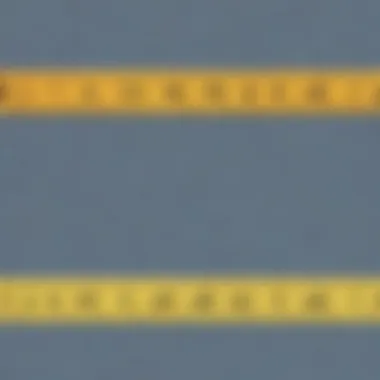Mastering the Order of Fractions: A Complete Guide


Intro
Understanding fractions can sometimes feel like trying to tame a wild horse. They can be tricky to grasp, but with practice and the right tools, mastering them becomes a rewarding journey. This guide takes a closer look at ordering fractions—one of the essential skills to learn in elementary mathematics. Whether you're a student or a parent looking to help your child, this article aims to clarify how fractions work, how to compare them, and why it matters in everyday life.
Fractions aren't just numbers; they represent parts of a whole. For example, when you enjoy a piece of pizza, each slice is a fraction of that pizza. Ordering fractions is crucial, especially when dealing with recipes or sharing things among friends. In this guide, we will explore various techniques, tips, and fun activities to make this learning process not just informative but enjoyable too.
Let's dive right into creative activities designed to reinforce fraction concepts in a fun and engaging manner.
Understanding Fractions
Fractions play a pivotal role in the world of mathematics. They represent parts of a whole and form the foundation for more complex mathematical concepts. Understanding fractions is not just an academic exercise; it helps in a variety of real-life scenarios, from cooking and construction to financial literacy. When learners grasp the importance of fractions, they can apply this knowledge effectively across countless situations, making it an essential skill for students of all ages.
Definition of Fractions
A fraction is a way to express a number that is not whole. It shows how many parts of a certain size we have. Generally, a fraction consists of two main components: the numerator and the denominator. They allow us to describe quantities that aren't whole numbers, making them invaluable in both everyday life and advanced mathematical work.
Components of a Fraction
-#### Numerator
The numerator is the top part of a fraction. It tells you how many parts you have. For instance, in the fraction 3/4, the 3 is the numerator. It signifies that you have three parts of whatever the whole might be. This is a key characteristic because without knowing how many parts you have, the fraction wouldn't communicate any useful information. The numerator's presence is a beneficial choice for simplifying fractions and helps students get a clearer picture of division and proportion.
-#### Denominator
On the flip side, the denominator is the bottom part and indicates into how many parts the whole is divided. Continuing with our earlier example of 3/4, the 4 is the denominator. This part is crucial as it gives context to the numerator; without it, the meaning of the fraction would be lost. It offers a unique feature—establishing the scale of the fraction. Understanding the denominator enhances students' comprehension of splitting and sharing quantities, a skill that comes in handy in countless real-world applications.
Types of Fractions
Fractions come in various forms, each serving its purpose depending on the context.
-#### Proper Fractions
Proper fractions are those where the numerator is less than the denominator. For example, 2/5 is proper because 2 is less than 5. This type of fraction showcases a portion that is less than a whole. The key characteristic of proper fractions is their ability to represent small parts of a whole, making them a popular choice in many everyday situations. Proper fractions can sometimes feel easier to grasp for learners, since they remain below one, which simplifies conceptualization.
-#### Improper Fractions
In contrast, improper fractions have numerators that are equal to or greater than their denominators, like 5/3. These fractions can represent quantities greater than one whole. One of the reasons why improper fractions are significant is their frequent appearance in advanced math concepts. They show the versatility of fractions in describing larger portions or multiples of quantities. Their unique feature lies in the way they blend simplicity with complexity, offering learners challenges that help them grow.
-#### Mixed Numbers
Mixed numbers are combinations of whole numbers and fractions, such as 1 1/2. This type integrates the ease of understanding a whole while adding the nuances of fractions. Mixed numbers are engaging because they connect more intuitively with students' everyday experiences—representing things like slices of pizza, where you might have one whole pizza and half of another. Their advantage, however, can turn into a disadvantage when it comes to operations like addition and subtraction, as understanding how to manipulate mixed numbers can require additional steps.
"Understanding different types of fractions is essential for students, as it forms a bridge to grasp more complex mathematical ideas later on."
In summary, recognizing different kinds of fractions and their components gives learners deeper insights, allowing them to tackle a variety of mathematical challenges with confidence.
Why Order Fractions?
Understanding why we need to order fractions lays the groundwork for grasping the many facets of fractions in both academic settings and daily life. Think of fractions as pieces of a pie. Knowing how to arrange these pieces contributes to clearer understanding and meaningful comparisons. This ordering becomes crucial especially when fractions share different denominators; it can dramatically change the equation. Here’s a breakdown of why putting fractions in order matters.
Importance in Mathematics
In mathematics, ordering fractions helps students develop critical thinking and reasoning skills. It’s not merely about stacking numbers; it’s about making sense of values and recognizing their relative sizes. By practicing fraction ordering, learners improve their ability to solve various arithmetic problems. It reinforces the concept of value and strengthens a student’s arithmetic fluency, allowing them to tackle more advanced math topics later on.
Ordering fractions teaches valuable lessons about equivalencies and comparisons, emphasizing that two numbers can look entirely different but represent the same quantity. This understanding is fundamental in honing analytical skills that are vital for further mathematics and science studies.
Real-World Applications
As with many concepts in math, understanding fractions extends beyond the classroom into everyday life. Let's chat about some real-world scenarios where ordering fractions plays a pivotal role.
Cooking and Measuring
When you step into the kitchen, fractions become your best friend. Recipes often require precise measurements to achieve the right flavor and texture. Imagine a recipe calling for three-fourths of a cup of flour, but your measuring cup only shows eighths. If you don’t know how to order fractions, you might end up with too much or too little, messing up your dish.
The beauty of cooking with fractions lies in adjusting recipes. If you're doubling a recipe, knowing how to correctly measure a fraction like one-third becomes crucial. This practical application not only illustrates the relevance of fractions but also encourages analytical thinking while cooking!
Sharing and Distributing
Another practical area is sharing or distributing items. Take a birthday party scenario: you have a big cake cut into eight equal slices, and you want to share it among friends. If two friends each take three slices, you need to know how much cake is left. If fractions aren't ordered correctly, you may end up in a sticky situation!
The process of dividing something into parts requires ordering these fractions to ensure fair sharing. Recognizing that three out of eight slices consumed leaves five slices promotes fairness and understanding within group settings. This is especially beneficial for elementary school children, teaching them about sharing and fairness in a tangible experience.
"The ability to order fractions effectively is akin to acquiring a toolkit that one can readily access—be it in crafting a delicious dish or ensuring equality in sharing."
Therefore, having these ordering skills translates to better problem-solving in day-to-day situations. More than just numbers on a page, this knowledge embodies a life skill, fostering cooperation and understanding among peers.
Through a blend of academic importance and real-world practicality, the act of ordering fractions stands undeniably significant. It enhances not just arithmetic capabilities but also broader cognitive skills that have lasting impacts through life.
Methods to Order Fractions


Ordering fractions is more than just arranging numbers; it’s about understanding relationships between quantities. Having the ability to order fractions efficiently equips students with essential mathematical skills. Various methods exist, each with its own advantages. Recognizing these methods helps one choose the best approach based on the problem at hand. This article will cover three primary methods that are particularly useful: finding a common denominator, using decimal equivalents, and applying the cross-multiplication technique.
Finding a Common Denominator
To begin, understanding how to find a common denominator is crucial. A common denominator allows for a straightforward comparison of fractions. When fractions share the same denominator, it's often just a matter of comparing their numerators. Here's how to tackle it:
- Identify the denominators. For example, consider the fractions 1/4 and 1/6. The denominators here are 4 and 6.
- Determine the least common multiple (LCM) of the denominators. The LCM of 4 and 6 is 12.
- Convert each fraction to an equivalent fraction with the LCM as the new denominator.
- Compare the new numerators. Now you can see that 3/12 is greater than 2/12, making 1/4 > 1/6.
- Changing 1/4 gives you 3/12 (because 1 x 3 = 3 and 4 x 3 = 12)
- Changing 1/6 gives you 2/12 (because 1 x 2 = 2 and 6 x 2 = 12)
Using this method makes it simple to order fractions, especially for beginners.
Using Decimal Equivalents
Another effective method to order fractions involves converting them into decimal form. This approach is particularly useful when fractions have different denominators that may complicate comparison. Follow these steps:
- Convert fractions to decimals. For instance, 1/4 can be converted by dividing 1 by 4, resulting in 0.25. Meanwhile, 1/6 gives approximately 0.1667.
- Compare decimal values. It’s easier to see that 0.25 is greater than 0.1667.
- Order the fractions based on their decimal equivalents. So in our example, 1/4 > 1/6.
This method is particularly useful because many students are more comfortable with decimals, increasing their confidence when dealing with fractions.
Cross-Multiplication Technique
The cross-multiplication technique is a bit of a gymnast’s leap into fraction comparison, providing a quick way to determine which fraction is larger without formalizing common denominators. Here’s how it works:
- Write the fractions side by side. Consider fractions 2/5 and 3/8.
- Cross-multiply. Here’s where things get simple: multiply the numerator of the first fraction by the denominator of the second, and vice versa. So for our example: 2 x 8 = 16 and 3 x 5 = 15.
- Compare the results. Since 16 > 15, it follows that 2/5 > 3/8.
This technique provides a quick assessment and can be particularly handy when faced with more complicated fractions or when trying to avoid tedious computations.
In summary, mastering these methods unlocks the door to a deeper, more intuitive understanding of fractions.
Examples of Ordering Fractions
Understanding how to order fractions can turn a challenging task into a straightforward one. In this section, we explore practical examples that illustrate different methods of arranging fractions. These examples provide clarity that boosts confidence for learners at all levels. Knowing how to order fractions isn’t just about mastering math; it’s about applying those skills in real life.
Example with Common Denominator
One of the clearest ways to compare fractions is to convert them into equivalent fractions that share a common denominator. Let’s say we have two fractions: 1/4 and 1/2. The first step is to find a common denominator. The easiest one to choose here is 4 since it is already the denominator of the first fraction.
To convert 1/2 into a fraction with a denominator of 4, we multiply both the numerator and the denominator of 1/2 by 2:
[ \frac12 = \frac1 \times 22 \times 2 = \frac24 ]
Now, we can compare 1/4 and 2/4 easily. Since 2/4 is greater than 1/4, we know that 1/2 is larger than 1/4. Using a common denominator simplifies the comparison greatly.
Example Using Decimals
Another effective method of ordering fractions is converting them to decimal form. This can be useful especially in situations where people are more comfortable with decimals. For this example, consider the fractions 3/5 and 4/7. First, convert both fractions to decimals.
For 3/5, divide 3 by 5:
[ 3 \div 5 = 0.6 ]
Next, for 4/7, divide 4 by 7:
[ 4 \div 7 \approx 0.5714 ]
Now that we have both fractions in decimal form, we can see that 0.6 is greater than approximately 0.5714. Thus, 3/5 is greater than 4/7. Converting to decimals can sometimes make fractions' values more intuitive, especially when working with money or measurements.
Example with Cross-Multiplication
The cross-multiplication technique is particularly powerful when comparing two fractions. Let’s take the fractions 2/3 and 3/5. Instead of converting each fraction, we can cross-multiply. For this, we multiply the numerator of one fraction by the denominator of the other:
- Multiply 2 (the numerator of the first fraction) by 5 (the denominator of the second fraction):
[ 2 \times 5 = 10 ]
- Now multiply 3 (the numerator of the second fraction) by 3 (the denominator of the first fraction):
[ 3 \times 3 = 9 ]
Now we have the two products: 10 and 9. Since 10 is greater than 9, we determine that 2/3 is greater than 3/5.


This technique is especially useful in situations where you want to quickly compare two fractions without additional calculations. The beauty of cross-multiplication is that it requires minimal steps for clear results.
Understanding these techniques in depth will enable learners to tackle ordering fractions with confidence, reducing anxiety often associated with math tasks.
Visual Aids for Understanding
Visual aids in mathematics serve as tools that help simplify concepts that may be otherwise tricky to grasp, especially for those just starting their journey in understanding fractions. They allow students to see relationships and comparisons visually, making it easier to order fractions without relying solely on numerical calculations. When young learners can visualize the information, it often leads to better comprehension and retention of the material.
The importance of visual aids cannot be overstated. They enrich the learning experience and can spark curiosity. Different types of visual tools cater to various learning styles. By incorporating these aids into the study of fractions, students can connect abstract mathematical ideas to tangible experiences in their daily life.
Fraction Number Lines
Fraction number lines are a fantastic way to intuitively understand the order of fractions. These lines display fractions in a linear format, allowing students to see how different fractions relate to one another. For instance, if you place the fractions 1/2, 1/3, and 1/4 on a number line, it becomes immediately clear that 1/2 is larger than both 1/3 and 1/4.
When using a number line, it's important to remember to mark equal spaces between the fractions to accurately display their values. This visual representation directly correlates with how we compare fractions in mathematics, providing clarity in understanding their order. Students can practice by creating their own number lines with fractions of their choosing, which serves as an effective hands-on learning tool.
Pie Charts
Pie charts are not just for statistics; they can also be a useful visual aid for understanding fractions! A pie chart divides a whole into different "slices," which can represent fractions visually. For instance, if a pie chart is divided into three equal slices, each slice would represent 1/3 of the pie. By coloring different fractions of the pie, students can quickly grasp which fractions are larger or smaller compared to others.
Using pie charts can also enhance discussions around equivalent fractions. For example, if one slice represents 1/2 of the pie, and two equal slices represent 1/4 each, students can visually connect these fractions and understand how they relate. This sort of visual differentiation can foster a deeper understanding of how fractions add up or compare to one another.
Bar Models
Bar models are another powerful way to visualize fractions. A bar model represents fractions as lengths of bars, which can be divided into equal parts. If we take a single bar and split it into 4 sections, then shade in 3 of these sections, it visually represents the fraction 3/4.
These bar models help in elucidating the concept of ordering fractions as well. Suppose you have 3/4 and 2/4; the student can see that the 3/4 bar is longer than the 2/4 bar, thus reinforcing the idea that 3/4 is greater than 2/4. When students actively engage with these models, they can more effectively visualize complex ideas like equivalent fractions and how to add or subtract them.
Visual representation is key to understanding. It brings clarity where numbers alone can confuse. Through visual aids like number lines, pie charts, and bar models, young learners can thrive in grasping the order of fractions and other mathematical concepts.
Common Mistakes to Avoid
When it comes to ordering fractions, there are some common blunders that can trip up even the best of learners. Understanding these mistakes is crucial because avoiding them makes the process smoother and more intuitive. It’s not merely about getting the right answer; it’s about understanding the ‘why’ behind every technique used. Let’s dig deep into these common errors so that learning about fractions becomes a walk in the park, not a rocky road.
Confusing Numerators and Denominators
One of the most frequent pitfalls students encounter is mixing up numerators and denominators. The numerator is the number on top of a fraction and indicates how many parts you have, while the denominator shows how many parts the whole is divided into. This seems simple, but in the heat of solving problems, it’s easy to get the two mixed up.
For instance, in the fraction ( \frac34 ), 3 is the numerator and 4 is the denominator. If a student mistakenly thinks that 4 is the numerator, they could end up concluding that ( \frac34 ) is larger than something like ( \frac23 ) without realizing that they’ve misinterpreted the relationship between the components. To make sure that this does not happen, a good practice is to clearly label the fractions at first and perhaps use physical objects, like blocks or counters, to visualize what each part represents.
Ignoring the Concept of Value
Another mistake some learners make involves overlooking the actual values of the fractions. It’s easy to get lost in the mechanics of ordering, using procedures like finding common denominators or converting to decimals, and forget that each fraction corresponds to a specific portion of a whole.
Take, for instance, ( \frac12 ) and ( \frac23 ). If a student only focuses on the denominators, they might assume that ( \frac12 ) is larger since it’s got a smaller denominator. However, when you convert both to decimals, you can clearly see that ( 0.5 ) is actually less than ( 0.666 ). Therefore, understanding that each fraction signifies a specific amount is essential in avoiding this trap. Making connections to real-life scenarios, like slicing a pizza or dividing a chocolate bar, can illustrate this point effectively.
Misapplying the Techniques
Misusing different techniques for ordering fractions is another common error. For example, while finding a common denominator is a solid method, if a student does it incorrectly, they can end up with incorrect comparisons. Misapplying cross-multiplication could lead to the wrong ordering as well if the calculations are off or if there’s confusion about which fractions to compare.
When using cross-multiplication, the student should remember that they need to multiply the numerator of one fraction by the denominator of the other and compare these products accurately. It’s easy to rush through this technique, especially during a timed assessment, resulting in careless mistakes.
To avoid such missteps, it’s prudent for learners to double-check their calculations and even consider a few practice rounds with direct supervision. Mistakes are part of learning, but recognizing and correcting them early on fosters a more solid foundation.
"Knowing what you don’t know is just as valuable as knowing what you do."
By navigating these common traps, learners can build confidence and clarity in their understanding of fractions, paving the way for more advanced math concepts later on.
Practice Problems
When it comes to mastering the order of fractions, nothing beats practice problems. They serve as both a testing ground and a learning opportunity. Engaging with these problems allows students to apply theoretical knowledge to real-world-like scenarios. Understanding how to order fractions properly isn’t just for solving homework; it has practical value, as it mirrors everyday situations involving sharing or comparing amounts.
Importance of Practice Problems
Just like a musician practices scales or a painter mixes colors to perfect their craft, pupils need to dive deep into fractions to truly grasp the concept. Here are some strong reasons why practice problems are a cornerstone of learning fractions:
- Reinforcement of Concepts: Repeating the ordering process helps solidify the understanding of fractions. Constant engagement turns uncertainty into confidence.
- Error Identification: Students can identify and rectify their mistakes in a safe environment. This process is key in developing critical thinking skills.
- Preparation for Advanced Concepts: Mastering the basics prepares learners for more complicated topics in mathematics like ratios or percentages.
“Practice doesn’t make perfect. Perfect practice makes perfect.”
– Unknown


Benefits for the Student
The advantages of working through practice problems are immense.
- Confidence Building: With each fraction ordered correctly, students grow their self-assurance, encouraging them to tackle even more challenging tasks.
- Engagement with Material: When students navigate problems, they engage actively with the learning material rather than passively receiving information.
- Variety of Approaches: Each problem might require a different strategy or method. This variability teaches flexibility in problem-solving.
Considerations about Practice Problems
As beneficial as practice problems are, there are a few considerations to keep in mind:
- Skill Appropriateness: Ensure that the problems are suitable for the learner’s current understanding. A challenging problem could lead to frustration rather than learning.
- Feedback Mechanisms: Provide opportunities for feedback, either through peer review or teacher evaluations. This reinforces the learning process.
- Progression of Difficulty: Problems should gradually increase in difficulty to maintain engagement without overwhelming students.
Simple Ordering Questions
When introducing practice problems, starting with simple ordering questions can make all the difference. Here, students can compare basic fractions, often using well-known examples:
- Order the following fractions from least to greatest: 1/4, 1/2, 1/3.
- Which is larger: 2/3 or 3/4?
- Arrange these fractions: 5/6, 2/5, 1/2.
Each question can help students recognize patterns or strategies, like finding a common denominator or converting fractions to decimals.
Challenges for Advanced Learners
For those who have grasped basic ordering skills, introducing more complex problems can support their growth. Here are some thought-provoking challenges:
- Find the order of the following fractions with larger denominators: 13/20, 7/10, 11/15.
- Convert and then compare: What is larger: 1/8 or 0.12?
- Mix it up: Order these mixed numbers: 2 1/4, 3 2/3, 1 5/8.
These challenges not only sharpen reasoning skills but also expand students’ mathematical toolkit, making them ready for future complexities in mathematics.
Thus, practice problems form the backbone of learning to order fractions. They establish a framework within which learners can explore, create, and perfect their understanding.
Resources for Further Learning
Learning about ordering fractions is not just a one-time event. It’s a journey that can be enriched and deepened by various resources available today. There’s a wealth of material out there that caters to different learning styles and needs. Providing access to a variety of these resources helps ensure that students, whether they are just starting out or looking to reinforce their knowledge, can find the support that works for them. Here are some key areas to explore:
Online Educational Platforms
Many online educational platforms offer engaging lessons about fractions, often with interactive features that make learning fun. Websites like Khan Academy and IXL provide lessons that adapt to the individual learner’s pace. This means students can revisit topics they find tricky or rush through the sections that come easily to them.
- Visualization: Online platforms typically use visual aids that help clarify concepts. Seeing fractions represented in various forms—like pie charts or number lines—makes it easier to grasp their relevance.
- Quizzes and Feedback: Many of these sites also include quizzes that give learners immediate feedback, which is crucial for understanding their strengths and weaknesses.
Interactions help to keep students engaged and often encourage them to take ownership of their learning.
Books and Study Guides
Books can be a treasure trove for learners who prefer offline study or want to be able to reference material without jumping between tabs. Many educational books aimed at elementary students tackle fractions in a clear and systematic way.
- Clear Explanations: These texts often break down topics into bite-sized pieces, with step-by-step instructions and exercises that reinforce learning.
- Diverse Approaches: Different authors might present similar content in unique ways, offering multiple perspectives that students can relate to.
Recommendations for effective study guides might include titles like "Fractions Done Right" or "Using Fractions in Everyday Life." A parent or caregiver can also read alongside their child, which can help facilitate discussion and enhance understanding.
Interactive Tools and Games
There are also numerous interactive tools and games designed specifically for teaching fractions. Educational apps and websites like Prodigy and SplashLearn make use of gamification, turning learning into an enjoyable experience. This enables students to practice their skills in a way that feels less like work.
- Fun Challenges: These platforms frequently incorporate challenges that encourage competition while still focusing on educational objectives. Students might race against the clock to solve fractions problems, adding an element of excitement.
- Progress Tracking: Many of these tools allow users to track their progress. It’s motivating for students to see their improvements over time, giving them a sense of accomplishment.
By utilizing a diverse array of resources, students can develop a richer understanding of fractions and how to order them effectively.
In summary, making use of online educational platforms, well-chosen books, and interactive tools can significantly enhance the learning experience for students tackling the sometimes challenging concept of fractions. Each type of resource contributes unique benefits, ensuring that learning remains both effective and engaging. The blend of these resources can cater to various learning styles, allowing students to not just memorize but really understand fractions.
Epilogue
Understanding how to order fractions is not merely an academic exercise; it's a vital skill that spans practical everyday situations. This conclusion summarizes important takeaways from the guide and encourages a deeper exploration of mathematical concepts.
Summary of Key Points
Throughout this article, we've explored several core ideas that underpin the ordering of fractions. Some key points include:
- Definition of Fractions: We started with the foundational concept of what a fraction is, breaking it down into its components: numerator and denominator.
- Ordering Techniques: Various methods such as finding a common denominator, using decimal equivalents, and employing cross-multiplication were discussed. Each method has its unique advantages that cater to different learning styles.
- Visual Tools: We highlighted how visual aids like number lines, pie charts, and bar models play a crucial role in grasping fractions. They simplify complex concepts and provide tangible ways to understand fractions in context.
- Common Pitfalls: Avoiding common mistakes is essential for mastering this topic. Misinterpreting numerators and denominators can lead to confusion, so understanding their roles is imperative.
- Practical Applications: We looked at how ordering fractions is relevant in day-to-day situations, such as cooking and resource allocation, showcasing the real-world implications of these mathematical concepts.
Encouragement for Continued Exploration
As you complete this guide, remember that mastering fractions is a stepping stone to more complex mathematical challenges. Continuing to explore the world of numbers can open new avenues in mathematics and even in fields like science, technology, engineering, and art. Here are a few ways to dive deeper:
- Practice Regularly: Just like riding a bike, the more you practice ordering fractions, the better you’ll get. Visit interactive platforms such as Khan Academy to find practice exercises.
- Explore Resources: Engage with targeted resources like Wikipedia or Britannica for deeper insights.
- Join Online Communities: Participate in forums like Reddit where other learners share their challenges and successes. This can provide additional tips and moral support.
- Fun Tools: Consider using apps and games designed for learning fractions. These tools can make learning enjoyable while reinforcing concepts you’ve studied.
In closing, the journey through fractions can lead to a significant increase in mathematical confidence and capability. Embrace the learning path ahead, and don’t hesitate to revisit concepts whenever you need a brush-up. Every bit of knowledge collected takes you one step closer to mastery!







